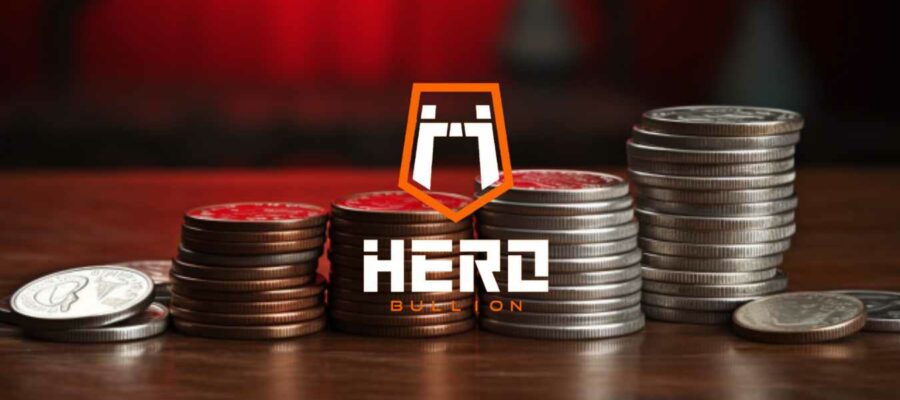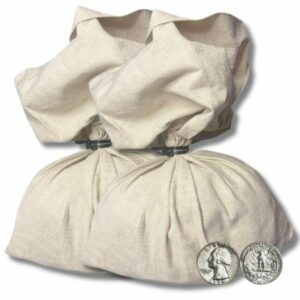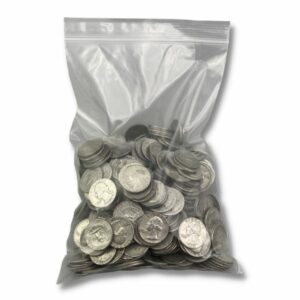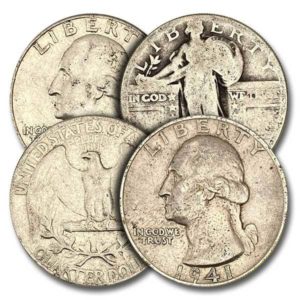Silver Quarter Vs Regular Quarter

With their shiny appearance and beautiful obverse/reverse designs, it’s easy to understand why some consumers mistakenly believe that circulation quarters contain pure silver. The reality, however, is that most quarters that you see contain no actual silver bullion. There was a period in American coinage history where quarters were minted using .90 pure silver. These .90 silver quarters are both valuable for their silver content and numismatic importance, making them excellent additions to any precious metal collection.
What’s the difference between a silver quarter vs regular quarter? We’ll cover all the bases in today’s Hero Bullion Academy guide. Investors should be aware of the differences between these two types of coins so that they don’t get scammed when it comes time to make a purchase.
Composition and Appearance
The composition and appearance of quarter-dollar is the most important consideration in their total values. Silver quarter vs regular quarter: how are they different in composition? Before you can understand how the two coins compare, you should have a solid grasp of how silver content compares between them.
Silver Quarters: Higher Silver Content, Distinctive Shine
Silver quarters, as the name suggests, contain actual silver bullion. Purity is standardized in silver quarters produced before 1964. Until then, quarters used 90% pure silver by weight. The presence of the precious metal in these older coins is one key to their total value. Silver quarter vs regular quarter: which is more valuable? Because coins minted before the year of 1964 contain actual silver, they’re worth far more than just 25 cents.

This high silver content also has an added benefit: shine. Silver is one of the most reflective metals on the planet; silver quarters offer a distinctive shine that modern quarters can’t match.
Regular Quarters: Copper-nickel Composition, Standard Appearance
Obviously, the quarters you receive for change at the gas station don’t contain actual silver. The U.S. Mint stopped producing coins with pure silver in 1965, so only coins minted in 1964 and before provide the hallmark shine of .90 silver. Modern coins actually contain zero percent silver bullion. Instead, they are minted using a core of copper surrounded by copper-nickel alloy.
Other than the lack of shine that characterizes earlier .90 silver coins, regular quarters look a lot like their high purity predecessors. Silver quarter vs regular quarter: which has the better design? They both feature an obverse depiction of George Washington and various different reverse artworks.
Value and Rarity
When we sat down to compare the silver quarter vs regular quarter, we knew that consumers would want to know about value and rarity. If you’ve read this far into our guide, you probably already know which of these coins are rarer. Coins minted before 1964 are numismatically valuable, and coins from this period in high condition might be extremely expensive to buy and sell.
Silver Quarters: Collectible Value Due to Silver Content and Scarcity
While regular quarters are really only useful for their face values, silver quarters contain pure silver and hold significant historical value to collectors. Silver quarter vs regular quarter: which of these coins is more scarce? New quarters minted with 0% pure silver are in extremely high supply. In fact, more are produced every single year. This knocks their resale value down considerably.
Silver quarters, on the other hand, are a finite commodity. No more 90% silver quarters will ever be produced, and the ones that exist now are at least 59 years old. Because of this fact, as well as the silver melt value of silver quarters, these coins are more expensive to buy and sell than regular quarters. When we compare a silver quarter vs regular quarters, it’s important that collectors understand how silver content and scarcity impacts the value of the former.
Regular Quarters: Face Value, Widely Available in Circulation
Like we explained above, regular quarters are only traded based on their face value. There are a few exceptions to this rule. Most notably, commemorative coins from the past few years with low mintage numbers might be worth quite a bit more than just 25 cents. But these coins are few and far between; most regular quarters are only with one-quarter of a dollar.
To properly compare a silver quarter vs regular quarter, investors should understand the value ceilings of both. While silver quarters are sometimes worth only their melt value in silver bullion, they have a much higher potential resale value than regular quarters.
Minting Years and Design Variations
Silver quarter vs regular quarter: which is older? Each of these coin types have been minted for decades, and the various designs offered by both quarters influence their values considerably. Below, we’ll compare minting years and design variations in the silver quarter vs regular quarter.
Silver Quarters: Production during specific years, unique designs
After 1932, silver quarters adopted the modern “Washington” design. On the obverse, this means the bust of George Washington, first President of the United States. On the reverse, coins minted from 1932 until 1964 feature the Heraldic Eagle of the United States, the hallmark reverse-side design found on modern non-silver quarter dollars.

Before 1932, a series of different designs made their way onto the obverse of the silver quarter. Silver quarter vs regular quarter: which has a higher design variation? If you count the various obverse-side designs featured on early American silver quarters, we find a higher degree of design variability.
Regular Quarters: Design changes over time, various mint marks
Silver quarter vs regular quarter comparisons should focus primarily on silver content, but design is also important to many collectors. Regular quarters, like their silver ancestors, have shifted in design over the past sixty years. If you’ve ever picked a regular quarter off the street or gotten one as change at the store, you’ll note that designs can vary significantly from year to year.
From 1999 to 2008, the U.S. Mint distributed a series of fifty regular quarter designs that celebrated every state in the union. These coins are actually bundled together in display packages and sell well among collectors of American coinage. While fifty regular quarters still won’t be as valuable as one extremely rare old silver quarter, some investors do love the look and feel of collectable copper-nickel quarter dollars.
Market and Collectability
Let’s compare the market and collectability of a silver quarter vs regular quarter. You shouldn’t have trouble finding a buyer for your .90 silver quarter, and it’s usually pretty easy to locate a collector willing to pay a high premium for an extremely rare silver quarter dollar. Things might get a bit trickier with non-silver regular quarters. We’ll discuss the collectability of the silver quarter vs regular quarter in the next two subsections.
Silver Quarters: Demand among collectors, potential for higher prices
Silver quarters are always in high demand. This is the case for a couple different reasons. First, these coins clearly contain a high percentage of pure silver. Some consumers may turn to silver quarters to stack silver without paying the high premiums associated with bullion coins like the American Silver Eagle. Others may consider the unique historical designs an excellent way to build numismatic value into their portfolios.

Over time, silver quarters can appreciate in value from rising silver prices and collectable demand. While some investors do stack regular quarters, collectors who want to profit from appreciation in the value of silver bullion generally prefer the high purity of silver quarters. It would be unfair to compare silver quarter vs regular quarter without considering how silver purity contributes to the potential for higher prices.
Regular Quarters: Collected for completeness, accessible to all
Compared to silver quarters, regular quarters aren’t quite so valuable to collectors. Silver quarters are collected individually for their silver content and historical value, but regular quarters are generally only collected for completion. In other words, someone might collect all fifty coins in the “50 state quarters” series, but they’re unlikely to pay hefty premiums to buy single coins. This doesn’t mean that regular quarters are without collectable value; certain coins with special or rare errors might be sellable at a premium to the right buyer, but we wouldn’t bet on this being the case for most regular quarters.
If we were forced to choose the better investment between a silver quarter vs regular quarter, our vote goes to the former.
Differences in Price and Worth
As we’ve covered a few times in this guide, the value difference between a silver quarter vs regular quarter is significant. We’ll take a deeper dive into the price gap separating the two unique quarter types in the next subsections.
Silver Quarters: Value based on silver content and condition
Silver quarters are valued based on both their silver content and condition, as well as the historical and numismatic value that they offer. Silver content is the easiest element of value to calculate. Each silver quarter contains .19084 troy oz of pure silver bullion. Multiply the is value by the current spot price of silver bullion and you’ll get the approximate silver melt value of a silver dollar.
Condition and rarity also play a role in determining the price and worth of a silver quarter. Silver quarters are extremely old, which means that very few of them remain in near-mint condition. If you have a silver quarter in excellent condition, it could be worth quite a bit more than its silver content might suggest. Coins from rare or low mintage years are also very valuable; some rare coins with special mint errors are worth hundreds or thousands of dollars!
Regular Quarters: Face value, limited numismatic significance
We’re comparing a silver quarter vs regular quarter, so it makes sense to spend just a moment discussing the value offered by regular quarters. Unfortunately for fans of modern American circulation coinage, regular quarters usually offer very little above their face value. That’s right – your non-silver quarters are worth around one-quarter of a dollar each. Like we discussed earlier, this isn’t always the case. In certain unique situations – such as rare circulation coins or coins with special error marks – regular quarters could be worth more than 25 cents.
Consult coin grading and value guides to figure out if your favorite regular quarter is valuable. But in most cases, the limited numismatic significance boasted by modern copper-nickel alloy quarter dollars means that they just aren’t worth very much money.
Practical Use and Circulation
Let’s compare one area of investment where modern, regular quarters might have the edge over .90 silver quarter dollars. Silver quarter vs regular quarter: which is more practical for use in everyday transactions. Unless you’re in the business of using $5 of silver to pay for $.25 of goods, the winner here is pretty clear.
Regular Quarters: Accepted in everyday transactions
Regular quarters are accepted in everyday transactions. Silver quarters are still currency, which means that they function as legal tender and can also be used to pay for goods and services. But most trades we conduct in everyday life rely on the face value of bills – not their ever-changing silver melt value. In other words, it’s easier to use regular quarters to pay for goods and services than silver quarters.
Special considerations when using or collecting silver quarters
Silver dollars require special considerations before purchase. We always recommend that investors take stock of their investment objectives, goals, and risk tolerance before investing in any new type of silver. Silver quarter dollars are no exception. Silver quarter vs regular quarter: which one is the riskier investment? Silver quarters will never stop being valuable; silver holds intrinsic value. But the low entry cost of regular quarters makes it easier for investors with limited funds to invest.
Ultimately, your own objectives should help you choose between silver quarter vs regular quarter stacking.
Final Thoughts: Differences Between Silver Quarter Vs Regular Quarter
We’ve given you all of the tools you need to differentiate between silver quarters and regular quarters. Ultimately, the main difference is pretty clear from the names of these popular investment vehicles and currencies. Silver quarters minted before 1964 contain 90% pure silver, compared to an utter lack of silver content offered by modern quarter dollar coins.
Are you interested in buying rare silver quarters? Hero Bullion is always happy to help new investors choose their next purchase.
About The Author
Michael Roets
Michael Roets is a writer and journalist for Hero Bullion. His work explores precious metals news, guides, and commentary.
